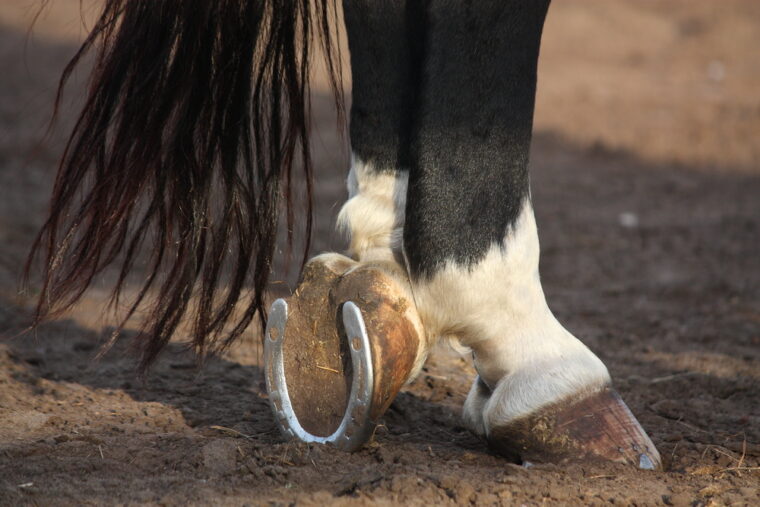
Horses that wear shoes do so for a variety of reasons, including hoof and foot protection, hoof fortification, improved balance and traction, and to prevent the wearing down of the hoof. Ultimately, whether or not a horse wears shoes comes down to the horse’s individual needs.
We’re all familiar with what a horseshoe looks like, but did you know that there are several types of horseshoes, each shaped differently and designed to cater to different needs? In this post, we’ll introduce six common types of horseshoes and how they differ from one another.
The 6 Types of Horse Shoes
1. Concave
Concave horseshoes are one of the most popular kinds of shoes for horses that are ridden due to their versatility—they’re what you might call the “all-rounder” of the horseshoe world. The concave shoe is designed to offer more grip, prevent slipping, and support the hoof and foot area in general. In addition to general riding, concave shoes are sometimes used in events and sports.
Concave horseshoes are also very lightweight, even if the shoe needs to be made wider or thicker for the horse’s needs. The extra traction these shoes can offer goes a long way in terms of increasing both the horse’s and rider’s confidence in navigating various types of terrain. All that said, though concave shoes are suitable for many horses, some horses might benefit more from another type.
2. Plain Stamp
Plain stamp horseshoes are flat, grooveless shoes commonly used for weighty horses, driving horses, and horses that take part in sports. They’re protective but aren’t good for traction, which is why they’re often used in sports. This is because horse sports arenas can be sticky, meaning less traction is necessary to prevent injury.
On the other hand, if your horse requires more traction, for example, if they’re often out on the roads, plain stamp shoes might not be the best option because they can be slippery.
3. Fullered/Creased
The fullered horseshoe—also known as a “creased” or “3/4 fullered shoe”—is a heavier kind of horseshoe designed to be wider than the foot and support the heels. For this reason, fullered shoes are sometimes worn by horses with foot conditions.
They have more grip than plain stamp shoes but don’t offer as much traction as concave shoes. If your horse needs a lightweight shoe that offers good traction, fullered shoes may not be the best choice.
4. Glue-on Shoes
Glue-on plastic horseshoes are an alternative option for horses with sensitive or painful feet on which hammering would not be a good idea. These may also be recommended for horses that are frightened of the loud hammering noise or horses in the transitional phase between shod and going barefoot.
This type of horseshoe lasts just as long as standard steel horseshoes and is applied with a special kind of adhesive that’s safe for horses.
5. Heart Bar Shoes
Also known as “frog support” shoes, heart bar shoes are often applied when a horse requires foot or hoof treatment. These shoes can offer support to horses experiencing a variety of conditions, including those that could render a horse lame.
The heart bar shoe shape is designed to take the weight off of painful or damaged areas, which helps support horses with damaged hoof walls. This design ensures that the weight is transferred to the frog, thereby allowing the damaged area to start healing while at the same time making the horse more comfortable.
6. Natural Balance
Natural Balance horseshoes work by minimizing stress on the navicular bone, which is located in the rear of the coffin joint in a horse’s hoof, with the ultimate goal being to protect the area and the tendons, tissues, and ligaments within from the forces of pulling and general stress. Natural Balance shoes might be recommended for horses suffering from back and foot issues or that often stumble or forge (when the hind foot comes into contact with the front foot during trotting or walking, resulting in a “clunking” or “clicking” sound).
Must All Horses Be Shod?
No, the decision as to whether to shoe a horse comes down to what’s best for the horse. Some horses need to wear shoes because they have issues with balance, need extra traction to navigate certain types of terrain, or have foot and/or hoof conditions that mean extra support is necessary.
If you’re unsure whether shoeing would benefit your horse specifically, please discuss it with your vet and farrier.
Are Horseshoes Painful for Horses?
If horseshoes are fitted by someone who knows what they’re doing, they should not cause any pain to a horse. The fitting procedure shouldn’t be painful, either, since there are no pain receptors in horse hooves. However, if the fitting is poorly done, it can cause pain to your horse, so it’s wise to only allow a professional farrier to do the job.
Summary
In brief, there are various kinds of horseshoes, with six of the most common being concave, plain stamp, fullered, glue-on, heart bar, and Natural Balance. There are so many different types simply because every horse has different needs.
Just because some shoes are designed to fit most horses—like the concave—doesn’t mean they’re right for every horse. Always go with a professional farrier’s advice to make sure your horse is fitted with the right kind of shoes for them.
Featured Image Credit: Anastasija Popova, Shutterstock









